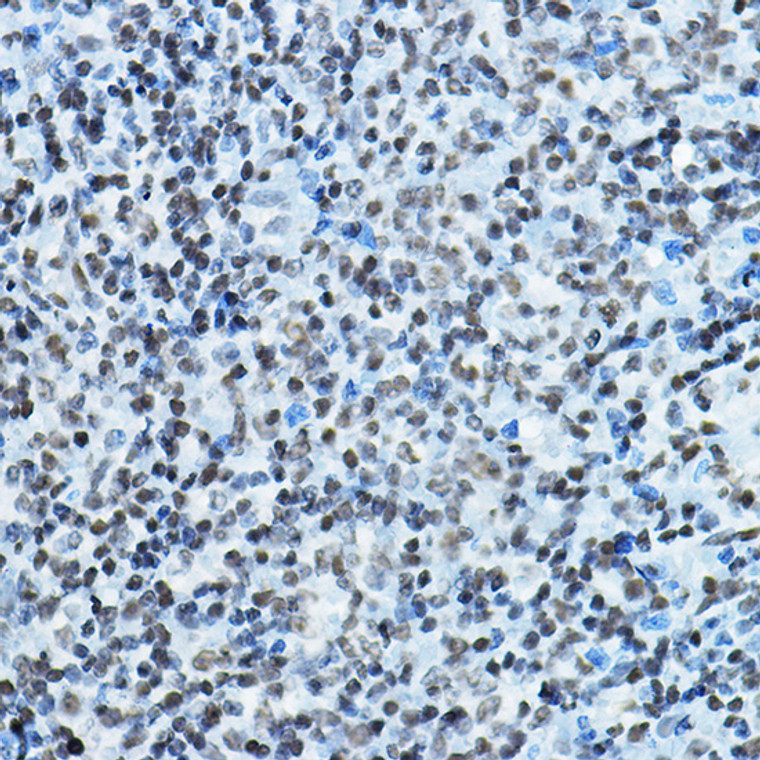| Host: |
Rabbit |
| Applications: |
WB/IHC |
| Reactivity: |
Human/Mouse/Rat |
| Note: |
STRICTLY FOR FURTHER SCIENTIFIC RESEARCH USE ONLY (RUO). MUST NOT TO BE USED IN DIAGNOSTIC OR THERAPEUTIC APPLICATIONS. |
| Short Description: |
Rabbit polyclonal antibody anti-KAT7 (55-193) is suitable for use in Western Blot and Immunohistochemistry research applications. |
| Clonality: |
Polyclonal |
| Conjugation: |
Unconjugated |
| Isotype: |
IgG |
| Formulation: |
PBS with 0.02% Sodium Azide, 50% Glycerol, pH7.3. |
| Purification: |
Affinity purification |
| Dilution Range: |
WB 1:500-1:2000IHC-P 1:50-1:200 |
| Storage Instruction: |
Store at-20°C for up to 1 year from the date of receipt, and avoid repeat freeze-thaw cycles. |
| Gene Symbol: |
KAT7 |
| Gene ID: |
11143 |
| Uniprot ID: |
KAT7_HUMAN |
| Immunogen Region: |
55-193 |
| Immunogen: |
Recombinant fusion protein containing a sequence corresponding to amino acids 55-193 of human KAT7 (NP_008998.1). |
| Immunogen Sequence: |
DSSPVRNLQSFGTEEPAYST RRVTRSQQQPTPVTPKKYPL RQTRSSGSETEQVVDFSDRE TKNTADHDESPPRTPTGNAP SSESDIDISSPNVSHDESIA KDMSLKDSGSDLSHRPKRRR FHESYNFNMKCPTPGCNSL |
| Tissue Specificity | Ubiquitously expressed, with highest levels in testis. |
| Post Translational Modifications | Phosphorylated at Ser-50 and Ser-53 by ATR in response to DNA damage, promoting its ubiquitination by the CRL4(DDB2) complex and subsequent degradation. Phosphorylation at Ser-50 and Ser-53 by ATR in response to ultraviolet-induced DNA, promotes localization to DNA damage sites. Phosphorylation at Ser-57 by PLK1 during mitosis seems important for prereplicative complex formation and DNA replication licensing, and requires prior phosphorylation at Thr-85 and Thr-88 by CDK1. Phosphorylated by MAP2K1, which accelerates its degradation. Ubiquitinated at Lys-338, leading to proteasomal degradation. Ubiquitinated by the CRL4(DDB2) complex following phosphorylation by ATR, leading to its subsequent degradation. Autoacetylation at Lys-432 is required for proper function. |
| Function | Catalytic subunit of histone acetyltransferase HBO1 complexes, which specifically mediate acetylation of histone H3 at 'Lys-14' (H3K14ac), thereby regulating various processes, such as gene transcription, protein ubiquitination, immune regulation, stem cell pluripotent and self-renewal maintenance and embryonic development. Some complexes also catalyze acetylation of histone H4 at 'Lys-5', 'Lys-8' and 'Lys-12' (H4K5ac, H4K8ac and H4K12ac, respectively), regulating DNA replication initiation, regulating DNA replication initiation. Specificity of the HBO1 complexes is determined by the scaffold subunit: complexes containing BRPF scaffold (BRPF1, BRD1/BRPF2 or BRPF3) direct KAT7/HBO1 specificity towards H3K14ac, while complexes containing JADE (JADE1, JADE2 and JADE3) scaffold direct KAT7/HBO1 specificity towards histone H4. H3K14ac promotes transcriptional elongation by facilitating the processivity of RNA polymerase II. Acts as a key regulator of hematopoiesis by forming a complex with BRD1/BRPF2, directing KAT7/HBO1 specificity towards H3K14ac and promoting erythroid differentiation. H3K14ac is also required for T-cell development. KAT7/HBO1-mediated acetylation facilitates two consecutive steps, licensing and activation, in DNA replication initiation: H3K14ac facilitates the activation of replication origins, and histone H4 acetylation (H4K5ac, H4K8ac and H4K12ac) facilitates chromatin loading of MCM complexes, promoting DNA replication licensing. Acts as a positive regulator of centromeric CENPA assembly: recruited to centromeres and mediates histone acetylation, thereby preventing centromere inactivation mediated by SUV39H1, possibly by increasing histone turnover/exchange. Involved in nucleotide excision repair: phosphorylation by ATR in response to ultraviolet irradiation promotes its localization to DNA damage sites, where it mediates histone acetylation to facilitate recruitment of XPC at the damaged DNA sites. Acts as an inhibitor of NF-kappa-B independently of its histone acetyltransferase activity. Plays a central role in the maintenance of leukemia stem cells in acute myeloid leukemia (AML). Acts by mediating acetylation of histone H3 at 'Lys-14' (H3K14ac), thereby facilitating the processivity of RNA polymerase II to maintain the high expression of key genes, such as HOXA9 and HOXA10 that help to sustain the functional properties of leukemia stem cells. |
| Protein Name | Histone Acetyltransferase Kat7Histone Acetyltransferase Binding To Orc1Lysine Acetyltransferase 7Moz - Ybf2/Sas3 - Sas2 And Tip60 Protein 2Myst-2 |
| Database Links | Reactome: R-HSA-3214847 |
| Cellular Localisation | NucleusChromosomeCentromereCytoplasmCytosolAssociates With Replication Origins Specifically During The G1 Phase Of The Cell CycleLocalizes To Transcription Start SitesLocalizes To Ultraviolet-Induced Dna Damage Sites Following Phosphorylation By AtrLocalizes To Centromeres In G1 Phase |
| Alternative Antibody Names | Anti-Histone Acetyltransferase Kat7 antibodyAnti-Histone Acetyltransferase Binding To Orc1 antibodyAnti-Lysine Acetyltransferase 7 antibodyAnti-Moz - Ybf2/Sas3 - Sas2 And Tip60 Protein 2 antibodyAnti-Myst-2 antibodyAnti-KAT7 antibodyAnti-HBO1 antibodyAnti-HBOa antibodyAnti-MYST2 antibody |
Information sourced from Uniprot.org
12 months for antibodies. 6 months for ELISA Kits. Please see website T&Cs for further guidance












